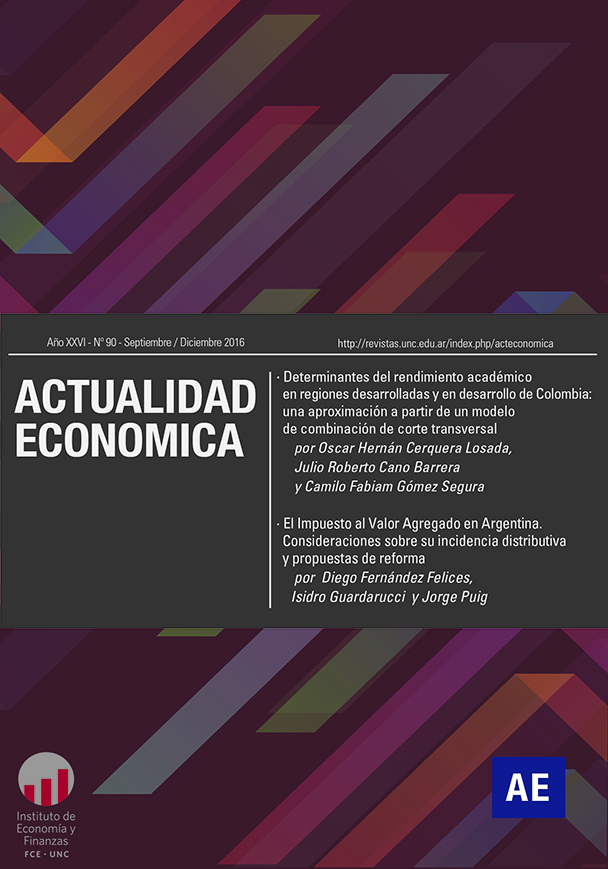The Value Added Tax in Argentina. Considerations on their distributive impact and proposals for reform
Keywords:
Value Added Tax, Distributive Incidence, National Household Expenditure Survey 2012-2013Abstract
This paper studies the distributive incidence of Value Added Tax (VAT) in Argentina using the National Survey of Household Spending (ENGHo) for the years 2012 - 2013 and analyzes different alternatives for tax reform. It examines the potential effects of reforms that convert VAT into a uniform tax rate, combined with different repayment mechanisms, via transfers to the most vulnerable sectors of the population. The results obtained indicate that the VAT is regressive using the per capita family income as an indicator of well-being, but practically proportional using the per capita consumption of the family. Differential treatments of the current scheme, generally associated with equity reasons, do not improve income distribution. The reform proposals presented here are distributively favorable compared to the current situation.
Downloads
References
Artana, D., Lavigne, P., Guardarucci, I., Puig, J. y Susmel, N. (2015). “El sistema tributario argentino. Análisis y evaluación de propuestas para reformarlo”, Fundación de Investigaciones Económicas Latinoamericanas (FIEL). Documento de Trabajo Nº 123.
Atkinson, A. B. y Stiglitz J. E. (1976). “The Design of Tax Structure: Direct Versus Indirect Taxation”, Journal of Public Economics, Vol 6(1), pp. 55-75.
Atkinson, A. B. y Stiglitz J. E. (1972): “The Structure of Indirect Taxation and Economic Efficiency”, Journal of Public Economics, Vol 1(1), pp. 97-119.
Boadway, R. (2012). From Optimal Tax Theory To Tax Policy. Retrospective and Prospective Views. Cambridge: MIT Press.
Corlett, W.J. y Hague D.C. (1953). “Complementarity and the Excess Burden of Taxation”, Review of Economic Studies, Vol 21(1), pp. 21-30.
Deaton, A. S. (1979). “Optimally uniform commodity taxes”, Economics Letters, Vol 2, pp. 357-361.
Diamond, P. y Mirrlees, J.A. (1971). “Optimal Taxation and Public Production”, American Economic Review. Vol 61(1): pp 8-27 y 261-278.
Fernandez Felices, D., Guardarucci, I. y Puig, J. (2014). “Incidencia Distributiva del Sistema Tributario Argentino”, Documento de Trabajo 105, Departamento de Economía, Facultad de Ciencias Económicas, Universidad Nacional de La Plata.
Friedman, M. (1957). A Theory of the Consumption Function, Princeton University Press.
Gasparini, L., Cicowiez, M. y Sosa Escudero, W. (2013). Pobreza y Desigualdad en América Latina. Conceptos, herramientas y aplicaciones. Editorial Temas, Buenos Aires, Argentina.
Gasparini, L. (1998). “Incidencia distributiva del sistema impositivo argentino”, en “La reforma tributaria en la Argentina”, Fundación de Investigaciones Económicas Latinoamericanas (FIEL).
Harberger, A. (1998). “Monetary and Fiscal Policy for Equitable Economic Growth,” en Income distribution and high-quality growth, V. Tanzi y K.-y. Chu (Eds). Cambridge and London: MIT Press , pp. 203-41.
Harberger, A. C. (1964). Taxation, resource allocation, and welfare, en The role of direct and indirect taxes in the federal revenue system, John F. Due (Eds). Princeton University Press, pp. 25-80.
Mirrlees J., S. Adam, T. Besley, R. Blundell, S. Bond, R. Chote, M. Gammie, P. Johnson, G. Myles y J. Poterba (Eds) (2010). Dimensions of Tax Design: The Mirrlees Review. Oxford University Press.
Ramsey, F. P. (1927). “A Contribution to the Theory of Taxation”, The Economic Journal, Vol 37, pp.47-61.
Stiglitz, J. E. (2015). “In Praise of Frank Ramsey’s Contribution to the Theory of Taxation”, Economic Journal, Royal Economic Society, vol. 0 (583), pp. 235-268, 03.
Downloads
Published
Issue
Section
License
Those authors who have published with this journal, accept the following terms:
Authors will conserve their copyright and guarantee the magazine the right of first publication of their work, which will be simultaneously subject to the Creative Commons Attribution-NonCommercial-NoDerivative 4.0 International License that allows third parties to share the work as long as the author and first publication of this magazine are indicated.
Authors may adopt other non-exclusive license agreements to distribute the published version of the work (e.g., deposit it in an institutional telematic archive or publish it in a monographic volume) provided that the initial publication in this journal is indicated.
Authors are allowed and encouraged to disseminate their work through the Internet (e.g., in institutional telematic archives or on their website) before and during the submission process, which may lead to interesting exchanges and increase citations of the published work. (See The effect of open access)









